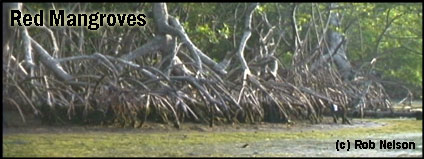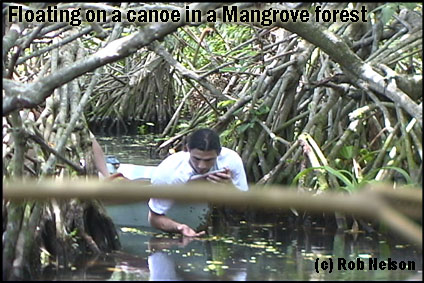


Mangroves
In this episode we'll learn:
- Where are mangroves found?
- Why is Osmosis important?
- Mangrove sediments.
- Mangroves in Mexico.
Mangrove Communities
The term mangrove is used for a group of salt-water tolerant plants.
Different mangrove tree species have evolved different adaptation
to exclude excess salt from the water.

Osmosis – Why is salt harmful?
Much of the salt may be excluded by the roots prior to water uptake but some salt often enters the plants and could potentially cause damage if not taken care of. Rhizophora sp. [Link to picture of Rhizophora] can transport salt ions to old leaves. The old leaves, that look yellow in colour, thus serve as salt storage compartments and are eventually shed by the tree.
So do mangroves only live in salt water?
Mangroves actually do not need the salt water at all to survive but are relatively poor competitors against other plants that occupy the zones farther up the coastline. Their special adaptations to survive in salt water allow these plants to live in a habitat only a few species of flowering plants can. Tests have been done with mangrove seeds and it has been found that they grow even faster and taller in fresh water compared to salt water if competition with other species is reduced [ ]. Around the world, mangrove communities are often found in river deltas where salty oceanic water meets freshwater from river output. Great tidal differences create strong mixing of water and often result in very turbid water with low visibility.
Where are mangroves found?
Mangrove communities are only found in tropical or sub-tropical areas of the world. To survive they need water temperatures above 24ºC in the warmest month. Mangrove communities also require annual rainfall that exceeds 1250mm, which is often the case in the tropics. These requirements are very similar to the needs of tropical coral reefs.
The ability of these trees to live in these rather exposed environments is aided by a number of mechanisms. Highly elaborate root systems give the trees support and prevent them from falling over as waves and tides exert their forces on the coast-line. Rhizophora mangle, a mangrove tree species generally found farthest out in the water, have aerial roots that look like a network of stilts standing out of the water. Rhizophora sp. is often what people first think of when talking about mangrove trees. The stilt roots provide extremely good support against physical environmental impact. Aerial roots are found amongst most mangrove tree species although they may be of different appearance. In Mexico the species Avicennia germinans [see picture bellow]] is predominantly found inside the outer zone of Rhizophora. Avicennia has another distinct rootsystem that looks like pencils sticking out of the sediment. These may get exposed during low tide.

A very important function of these aerial roots besides giving the plant support is oxygen uptake for root respiration since the roots cannot receive much oxygen in the sediment.
An additional positive but indirect effect of this dense network of roots is that they also bind sediment. Tropical areas of the world often have seasonally heavy rainfall. The rain flushes large amounts of sediment out to sea. Sedimentation is one of the major threats to the coral reefs of the world. The symbiotic zooxanthellae algae, providing sometimes almost all the energy needed by the coral polyp, is dependent on sunlight for photosynthesis. Increased turbidity decreases the depth that sunlight can penetrate and can thus lead to coral death. Sediment can also cover the corals directly and kill it. Since both mangroves and coral reefs are generally found in the same areas o the world, the mangroves serve as a sieve that retains much of the sediment and thus prevents it to get flushed out to the coral reefs.
Mangrove sediment:
The sediment around mangrove areas is generally composed of very fine silt or mud particles. These densely packed particles make the sediment very oxygen poor. The only organisms that can survive and thrive in this oxygen free environment are bacteria. The bacteria can reduce sulphur instead of oxygen for respiration giving these environments a very distinct and strong smell of sulphur (rotten eggs). The bacteria on the other hand provide an important first step in the mangrove community food chain. Bacteria are decomposers that break down and convert all dead organic material into useful nutrients that are released into the water. These can ,in turn, be utilised by other organisms in the surrounding water. So even though the sediment in mangrove communities itself does not provide a good habitat for much marine life, the surrounding water can sustain an enormous diversity of organisms.
The complex structure provided by the network of mangrove roots also provide very important nursery areas for marine life such as reef fish, prawns and crabs. Reef fish spawn in the mangrove habitats, the fertilized eggs develop into juvenile fish, that remain in the mangrove areas and are protected from large predators until they are large enough to make their way out to the coral reefs.

Mangrove Species found in Mexico:
1) Red mangrove – Rhizophora mangle
Grows farthest out in the water, has stilt roots, excludes salt through old leaves, long propagules that they drop and may float for months to new locations
2) Black mangrove – Avicennia germinans
“prop” or “pencil” roots, grows generally just inside of Rhizophora zone
3) White mangrove –
Links to mangrove sites:
- Australian Institute of Marine Science:
- http://www-personal.usyd.edu.au/~nicksk/course/mangrove/Default.html
- http://www.env.qld.gov.au/environment/coast/habitats/m.html
TEXT BY JONAS.

